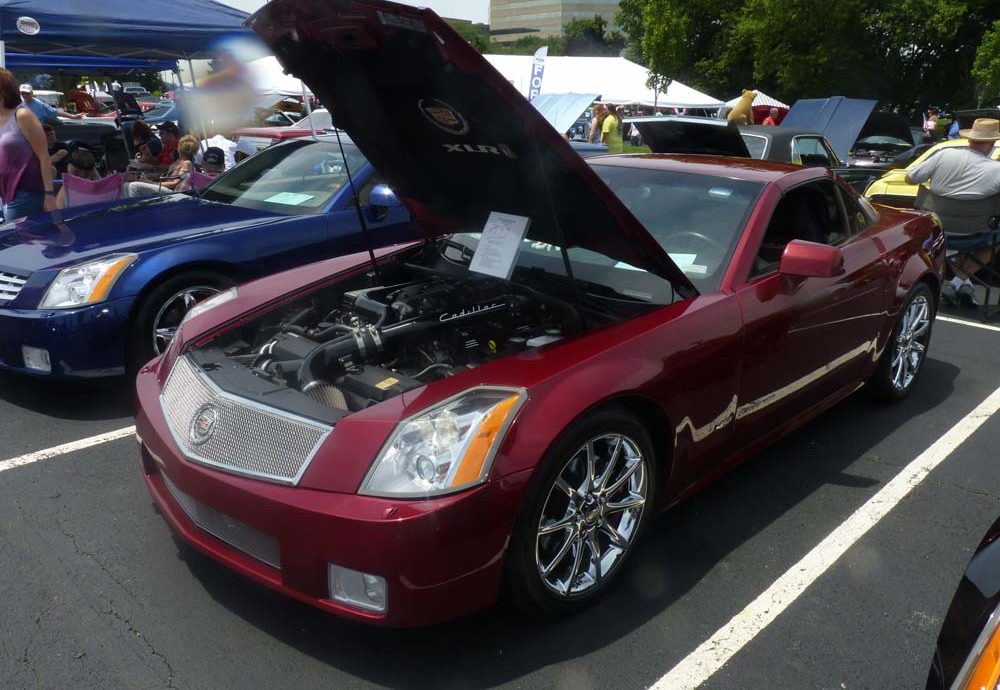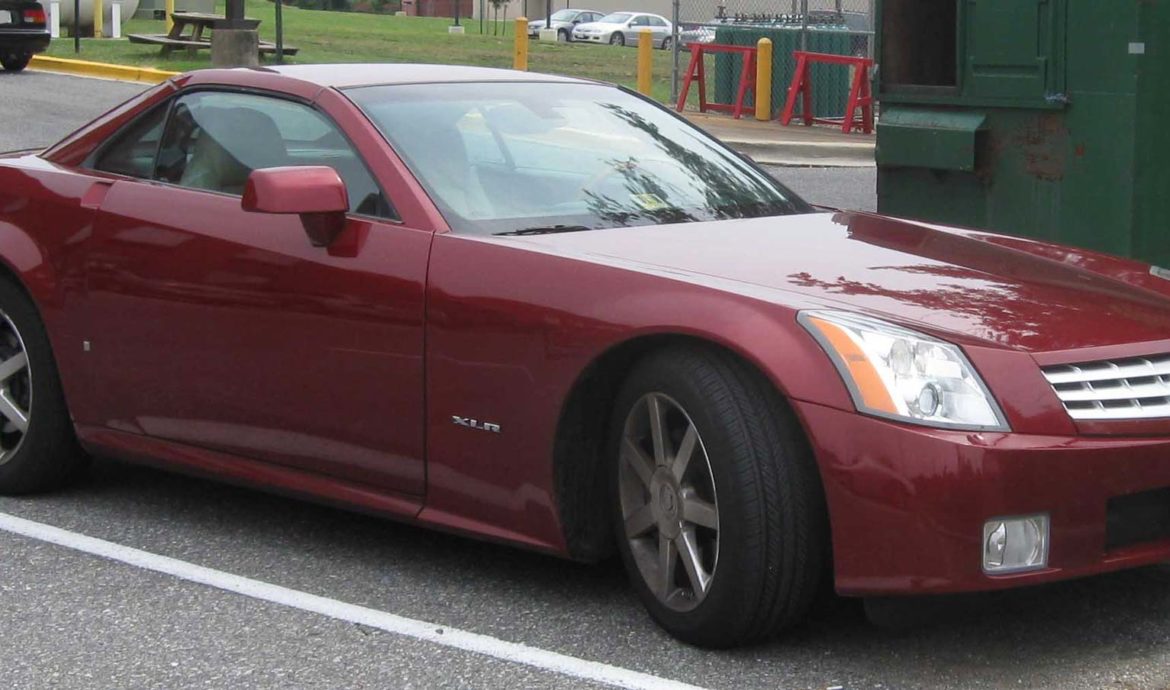This article was originally written in 2016 so there may be several out of date references. I’m not changing it because I believe those references are a neat little retrospective time capsule of what we were talking about as a community only a few short years ago.
America seems to run on a cycle. Every 4 years there’s a presidential election, every 8 months there’s a mass shooting, every 3 weeks there’s a new block-busting superhero movie, and every other Monday there’s a new rumor about a mid engined Corvette. This rumor first sprung into existence back during the New Testament, possibly predating the birth of Jesus Christ, but the most recent whispers came in the form of actual spy photos of a camo’d up mule driving down the highway, accompanied by a C7 Corvette. Obviously people were quick to jump to the C8/Zora/ZR1 conclusions, but spotted here and there amongst various comments and boards I saw suggestions that it might actually be some sort of Cadillac supercar, as they’ve toyed with the idea in the past and are currently in search of the same reputation bestowed upon their European competitors, it would almost make sense for them to have a supercar.

I want it to be known that I personally don’t think this spied supercar will be a Cadillac, but thinking about the prospect is fun. The Cien concept from the early 2000s is the first car that sprung to mind, which was in fact a mid engined supercar, sporting a V12 claiming 750 horsepower. The Cien was the only real supercar idea to come from Cadillac, but the thought of having some ridiculous halo car has clearly existed in their heads for the past decade or so, from the Sixteen concept which sported a 13.6 Liter V16 engine, to the more recent Elmiraj concept which evokes memories of the Caddy’s from the 60s and 70s that various pimps, ballers, and gangsters enjoy driving.

There was one time, either by accident or as some sort of cruel joke, that one of these “Super Caddies” actually did make it past the filters and saw actual production, but it wasn’t the one that anybody asked for or wanted: The Cadillac XLR.
What is it that makes the Corvette such a great car? Firstly it’s inexpensive, at least comparatively to other two seaters with similar performance numbers. It can be had with a stick shift transmission, a feature that seems to be growing more and more uncommon. It’s fairly light weight, and the puts a large focus on sporty handling, making it a true driver’s car. You can’t make a list of reasons why the Corvette is excellent without noting the LS/LT engine, with its light weight, simplicity, reliability, and borderline obsession with aftermarket parts and big power figures, it’s no wonder why the Corvette’s power plant is is so revered in the car community. So what would ruin the Corvette? If they took all of those things away? Someone should have told that to Cadillac, because they built the worst Corvette in recent memory.
The XLR showed up around 2003 as a 2004 model, and at first glance it almost looked like a coupe version of the recently launched CTS. Continuing in the aggressively straight and pointy design language, and the nonsensical three letter naming scheme (that totally wasn’t a mimic of what the German and Japanese luxury manufacturers were doing) the XLR looked like a pure blooded Caddy, at least until you saw one parked next to a Corvette at the dealership. The XLR was neither C5 or C6 based, coming out the final year of the C5’s production run and predating the C6 by a few months, the XLR had some sort of weird pubescent C5.5 chassis. If the C5 were a caterpillar and the C6 a butterfly, the XLR would be the cocoon. When you were a kid, did you ever try breaking open a cocoon in hopes of helping release a butterfly? If you did, you’d know that the cocoon is by far the shittiest stage of development for a butterfly.

The Corvette has always been well known for being… how do the poor people say it? Cost effective? The Corvette is cheap. Up until the C7 came out, the ‘vette was notorious for using interior bits with the least expensive bits of plastic garbage the designers could manage to pull from their parts bins, and the general flimsy build quality was mocked relentlessly by Porsche owners the world over. Sure, the C5 did have the build quality of a Cavalier, but we could always forgive GM because the Corvette’s price reflected that. And who cares about interior necessities anyway, you wanted a sports car damn it. If you wanted something fancy and expensive you would have gotten a Cadillac! Um… Yeah, so the XLR was a thing, and one of the (few) selling points it had was that it was a Corvette with an interior that wouldn’t make you feel like a working class citizen every time you opened the door. But here’s the thing, GM thought they were making some sort of grand touring sports car to compete with the European offerings, so they encroached on European prices. The XLR started around $75K USD and with options it would creep over the 6 digit mark, making it one of the most expensive cars GM ever made. I know what you’re thinking, “But I’ve seen top tier Corvette’s crest $100K before!” Yes, you have, but keep in mind that in 2004 a brand new Corvette started around $40K with a Z06 sitting somewhere in the $50K range. If Cadillac was trying to reel in the older Corvette crowd with the XLR, there’s no doubt that many of them would have experienced some serious sticker shock when comparing the two cars.
Oh, did I imply that the XLR had a nice interior? Because I didn’t mean to, sorry for that. This was early 2000s Cadillac remember, their idea of a nice interior was “put a Chevy interior in something then throw as much beige and woodgrain panelling as possible at it until we forget it was once a Chevy interior.” Yes, I suppose the big touchscreen and dual zone climate controls would have been pretty bitchin’ in 2004, but once again comparing anything of a similar vintage from a European luxury brand makes the interior of the Caddy look cheap and boring. Plus by the time the XLR finally died in 2009 we were seeing a new wave of technology, making many of the cutting edge features in the XLR almost mainstream in sedans and SUVs at a fraction of the price. Things like a built-in DVD player almost seem silly today, but I can see how that would have been pretty cool a decade ago.

The XLR was actually not terrible in the handling department. The brakes and suspension were mostly carried over from the C5 Corvette, with a little more suspension travel added in the help with that classic Cadillac ride quality. The XLR even had magnetic shock absorbers, which honestly could have been the XLR’s greatest contribution to the rest of the GM lineup moving forward, as that suspension technology has crept into just about every premium offering GM has today. The XLR was noted for being pretty weak in the rubber department though. With 235 width tires on each corner it wasn’t breaking any cornering G force records. It handled like a slightly more comfortable Corvette, and if that’s what Cadillac was shooting for, it was one of the few things the XLR actually succeeded in.
One figure that didn’t help the XLR in terms of handling was the number that popped up on the scales. Weighing in somewhere close to 3900 pounds, the XLR was obese compared to the ~3300 pounds the Corvette sported, and with the Chevys tire advantage and stiffer shocks there was no doubt that the cheaper car was not only more powerful and quicker in a straight line, it could tackle a corner better as well. Even at that weight, the Caddy was still a good few hundred pounds shy of what the SL500 roadster checked in at. The Cadillac also had a pretty nifty automatically folding hardtop, one of the few genuine kudos I can give to the car, even if it added weight and unneeded complexity.

Speaking of unneeded complexity, one place where the Corvaddy fell flat on its face was under the hood. In place of the LS6 from the C5, or LS2 which happened to show up alongside the C6, Cadillac opted to use their own 4.6L Northstar V8. Now, this wasn’t unheard of, back when GM was the parent company to what seemed like dozens of brands, every badge wanted their own engine, so Pontiac used a separate engine from what Chevy offered, Olds used different motors than Buick, Cadillac had their own fleet of engines, and so on. Cadillac wanting to use their own engine over Chevy’s small block wasn’t out of character for them. What was weird was how they opted to use the Northstar when the LS was better in literally every conceivable way. See, the Northstar V8 came to fruition in the early 90s as a sort of “challenge accepted” to the overly complicated engines coming out of German factories. I like to picture a bunch of suits sitting around a big desk in a boardroom surrounded by 80s decor, trying to explain to some poor engineers how they want to intentionally make their new engines as terrible as possible in some sort of demented marketing scheme to seem more European. The result was the overhead cam, 32 valve Northstar V8, displacing 4.6 liters and dollar bills from wallets for years to come. The Northstar was horribly unreliable. In fact, it was so unreliable that Cadillac practically had to invent the now common “limp home mode” that allowed the engine to operate at minimum capacity if… when something failed, to prevent further damage. How overly complicated was it? Well, they decided the alternator needed to be liquid cooled for a few model years because… reasons? I think the official reasoning was to help the alternator survive, but the ensuing shit show that came with all the extra plumbing and complication made Cadillac switch back to a normal alternator, which seemed to have no effect on longevity, it was terrible regardless.
So why did Cadillac want this horribly unreliable piece of junk powering their flagship car? The diehards will spew something about wanting to sustain the sanctity of Cadillac exclusivity, but I’ll dismiss that pointing out that the entire rest of the car is pretty much a Corvette. Honestly, I’m not sure what their reasoning was. The 4.6L made 320 horsepower when the LS6 was making 405 so they can’t tell you it was for an advantage in performance. They also can’t tell you it was a packaging issue as Cadillac engineers actually had to extend the wheelbase of the Corvette chassis to clear the larger overhead cam Northstar engine. They can’t say it was to make a more reliable car because of reasons listed above. It sure as Hell wasn’t to keep costs down, the Northstar being a much more expensive engine to produce. What’s even more confusing is that the CTS-V from the same time period (or all of the CTS-Vs for that matter) did use an LS engine from Chevy, so it’s not like Cadillac was allergic to pushrod V8s. The only, and I mean only viable reasoning I can think of for using a Northstar over an LS is because the Northstar might run a little more smooth, which is important for a flagship Cadillac… but would a smooth idle outweigh the horrendous reliability records and performance disadvantages that the XLR ended up with?
To address some of these shortcomings, Cadillac introduced the XLR-V in 2006. Like other Cadillacs whose names end with a V, this one was faster than the base model. Unlike other Cadillacs whose names end with a V, nobody really seemed to care. Instead of doing something logical, like, I don’t know, using an LS6, they decided to plop a supercharger on the Northstar. They went down to a 4.4L V8 to help with strength, and the end result produced 443 horsepower and 414 lb-ft of torque. That’s all fine and dandy, until you look at the rest of Cadillac’s lineup from 2006 and see something called an STS-V, which had the exact same engine and for some reason produced 469hp and 439 lb-ft. I… uh… what? Cadillac, why would you detune a performance engine before putting it in your flagship performance car? What is your reasoning for this? Out of all the confusing and terrible decisions you made regarding the XLR, shaving 26 potential horsepower off your spec sheet was one of the worst.

The XLR-V also decided to throw in some handling upgrades over the base model. They threw the brakes found on the Z51 packaged C6 Corvette behind the rims, and the widened the rear tires to 255 width… and that was about it. With a 0-60 run in the mid 4-second range, ¼ mile in the low 13s, and a top speed of 155mph, the ‘V wasn’t slow by any means, but it isn’t exactly impressive given its $110K USD sticker. To be fair, these numbers were almost identical to what the SL55 AMG was capable of at the time as well.

So, what was the XLR? A grand touring Corvette? A Caddy flagship? A probe sent out into the market to see what people might think of a supercar wearing a Cadillac badge? Well, ultimately, the XLR was a failure. From 2004 to 2009 they only sold around 15,000 of them. Uh, 2009 model year, seeing as how you could still buy them brand new in 2011 because they had so many leftovers and couldn’t sell them all. Seeing as how the C5 sold over 30,000 units per year while it was in production, I would hazard a guess and say that the XLR was a sales disaster. Cadillac was hoping to sell at least 5000 units a year, seeing as how there were 9 years you could actually buy one new and they sold 15,000 of them, I find it hard to believe that Cadillac is in any sort of hurry to jump back into the premium sports car market, let alone the supercar one. I’m not saying I don’t want to see a production Cien, I’m just saying that I don’t think it’s very likely.






